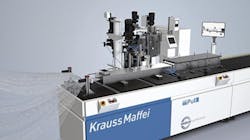KraussMaffei has unveiled its iPul machine, a new pultrusion system that offers faster production speeds.
Pultrusion is used to make profiles from fibers or woven or braided strands impregnated with resin. The name pultrusion is a combination of "pull" and "extrusion." Unlike extruders, which push the material, pultrusion machines work by pulling the material.
KraussMaffei discussed the technology May 18 during its Tech Day at its Brighton, Mich., plant.
In the iPul pultrusion process, glass, carbon, basalt or aramid fibers are pulled from a fiber rack across fiber guides and through an injection chamber.
"The direct injection of the matrix material using a metering machine and an injection chamber offers clear technical and economic advantages compared with the typical market practice where the impregnation is generally effected by pulling the reinforcement through a bath," said Josef Renkl, head of pultrusion development at KraussMaffei.
The metering machine heat-balances and mixes the matrix material in a mixing head and conveys it into the injection chamber. In the chamber, the fibers are saturated with an optimum level of matrix materials at an inner pressure of 5 to 100 bar. Then, the final shaping and curing of the profile takes place in various heating zones within the die. Temperatures typically vary from 212 to 482 degrees Fahrenheit, according to the company.
"Impregnation of the fiber is much better," said Philipp Zimmermann, KraussMaffei's product and sales manager for composites and surfaces. "You can create higher import pressures there."
Then the profiles are cut to the desired length using a saw.
The company is offering the machines for sale worldwide. Initially, they are being manufactured in Munich, but the company plans to expand production to other areas, including North America, said Wolfgang Hinz, product and sales manager for composites and surfaces at KraussMaffei.
KraussMaffei began developing its pultrusion technology about a year and a half ago based on market research regarding future growth opportunities, Zimmermann told Tech Day attendees.
"We looked at different composite technologies, and we saw one of the largest improvements was going to be in the pultrusion process over the next few years," Zimmermann said.
The new pultrusion machines combine the direct injection of the matrix material — PU, epoxy or polyamide — and the radial pultrusion process in a unique way, according to the company.
The new machine design is more compact and the production speeds are higher. Speeds for traditional pultrusion are generally about 1.5 feet to 5 feet per minute.
However, KraussMaffei is aiming for production speeds of about 10 feet per minute with the iPul.
"This opens up completely new markets for pultrusion," Renkl said.
At the moment, KraussMaffei is working with end users to develop three products: wind turbine blades, window profiles and rebar, Zimmermann said. "We not only are focusing on the production equipment, we also are focusing on products."
The iPul technology is well-suited for the wind energy industry because pultruded profiles are characterized by high fiber content, which offers a combination of high strength and low weight. That allows for construction of larger wind blades. KraussMaffei is partnering with Huntsman Corp., The Woodlands, Texas, on the production of pultruded reinforcement elements for large rotor blades in wind turbines.
For window profiles, pultruded PU offers significantly better mechanical characteristics than PVC, according to the company. KraussMaffei is teaming with Covestro, a Leverkusen, Germany, supplier of high-tech polymers, to develop profiles for use in manufacturing large windows.
The company is working with Evonik Industries AG, Essen, Germany, on developing epoxy resins with glass fibers for concrete reinforcement.
Bruce Geiselman, senior staff reporter
Contact
KraussMaffei Corp.,Florence, Ky., 859-283-0200, www.kraussmaffeigroup.us
About the Author
Bruce Geiselman
Senior Staff Reporter Bruce Geiselman covers extrusion, blow molding, additive manufacturing, automation and end markets including automotive and packaging. He also writes features, including In Other Words and Problem Solved, for Plastics Machinery & Manufacturing, Plastics Recycling and The Journal of Blow Molding. He has extensive experience in daily and magazine journalism.

